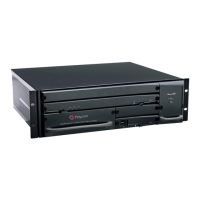POLYCOM REALPRESENCE COLLABORATION SERVER V.8.6 VIRTUAL EDITION INSTALLATION
INSTALL POLYCOM REALPRESENCE COLLABORATION SERVER, VIRTUAL EDITION SOFTWARE WITH YOUR VIRTUAL ENVIRONMENT TOOLS
POLYCOM REALPRESENCE COLLABORATION SERVER GETTING STARTED GUIDE 9
• Network Interface Card - Depending on the environment, the virtual
machine may require a Network Interface Card (NIC) from the host dedi-
cated for the virtual machine.
• Dedicated VM Server - To maximize audio and video quality Polycom
strongly recommends a dedicated VM server per RealPresence Collabora-
tion Server.
CPU Allocation
• Leave 2 cores unallocated, regardless of the number of cores present, how
many licenses are purchased, and what other virtual machines will be
present.
• For VMware, do not allocate CPU core 0. Host operating system perfor-
mance may be affected if this core is assigned to the virtual machine.
• When possible, allocate cores on one CPU. This will enhance performance
by reducing CPU-to-CPU communication times.
• Do not use processor oversubscription; maintain a 2:1 ratio of virtual CPU
to physical CPU. For example, a system with 8 physical cores can support
up to 16 virtual processors divided up into any combination among the
virtual machines running on that host.
• When you are using Hyper-V, Polycom recommends disabling the
Virtual Machine Queue of the Network Interface Card (NIC). For more
information, see https://support.microsoft.com/en-us/kb/2902166.
NOTE: CPU reservations can only be done after shutting down the virtual
machine.
Memory Allocation
In a Microsoft Hyper-V environment, you must not overprovision memory at
the hypervisor layer. Dynamic memory for virtual machines is not supported.
Disk
Hypervisors add overhead to disk operations. For best performance, insure that
the virtual machine is able to achieve the recommended IOPS in the table listed

